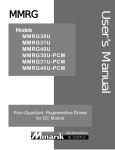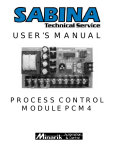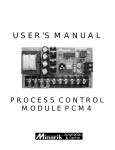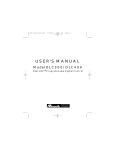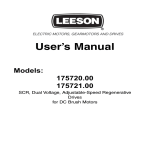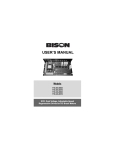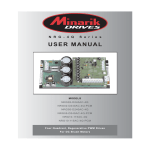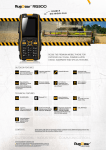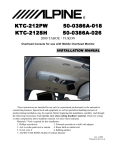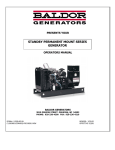Download USER`S MANUAL - Minarik Drives
Transcript
USER’S MANUAL RG300 and RG400 Series SCR, Adjustable Speed, Regenerative Drives for DC Brush Motors Copyright 1998 by Minarik Corporation All rights reserved. No part of this manual may be reproduced or transmitted in any form without written permission from Minarik Corporation. The information and technical data in this manual are subject to change without notice. Minarik Corporation and its Divisions make no warranty of any kind with respect to this material, including, but not limited to, the implied warranties of its merchantability and fitness for a given purpose. Minarik Corporation and its Divisions assume no responsibility for any errors that may appear in this manual and make no commitment to update or to keep current the information in this manual. Printed in the United States of America. m Safety Warnings m • This symbol denotes an important safety tip or warning. Please read these sections carefully prior to performing any of the instructions contained in that section. • Have a qualified electrical maintenance technician install, adjust and service this equipment. Follow the National Electrical Code and all other applicable electrical and safety codes, including the provisions of the Occupational Safety and Health Act (OSHA), when installing equipment. • Reduce the chance of an electrical fire, shock, or explosion by proper grounding, over-current protection, thermal protection, and enclosure. Follow sound maintenance procedures. • It is possible for a drive to run at full speed as a result of a component failure. Please ensure that a master switch has been placed in the AC line to stop the drive in an emergency. • This drive is isolated from earth ground. Circuit potentials are at 115 VAC or 230 VAC above earth ground. Avoid direct contact with the printed circuit board or with circuit elements to prevent the risk of serious injury or fatality. Use a nonmetallic screwdriver for adjusting the calibration trimpots. ii Contents Specifications 1 Dimensions 3 Regenerative Drives 6 Installation 8 Mounting chassis drives . . . . . . . . . . . . . . . . . . . . . . . . . . . . . . . . . . . . . . .8 Mounting cased drives . . . . . . . . . . . . . . . . . . . . . . . . . . . . . . . . . . . . . . . .9 Cage-clamp terminal block . . . . . . . . . . . . . . . . . . . . . . . . . . . . . . . . . . . .11 Screw terminal block . . . . . . . . . . . . . . . . . . . . . . . . . . . . . . . . . . . . . . . . .12 Heat sinking . . . . . . . . . . . . . . . . . . . . . . . . . . . . . . . . . . . . . . . . . . . . . . .13 AC line and motor connection . . . . . . . . . . . . . . . . . . . . . . . . . . . . . . . . . .13 Field output . . . . . . . . . . . . . . . . . . . . . . . . . . . . . . . . . . . . . . . . . . . . . . . .15 Speed adjust potentiometer installation . . . . . . . . . . . . . . . . . . . . . . . . . . .16 Speed adjust potentiometer connections . . . . . . . . . . . . . . . . . . . . . . . . . .17 Line fusing for RG300/400 Series . . . . . . . . . . . . . . . . . . . . . . . . . . . . . . .18 Voltage follower . . . . . . . . . . . . . . . . . . . . . . . . . . . . . . . . . . . . . . . . . . . .19 Operation 20 Before applying power . . . . . . . . . . . . . . . . . . . . . . . . . . . . . . . . . . . . . . .20 Startup . . . . . . . . . . . . . . . . . . . . . . . . . . . . . . . . . . . . . . . . . . . . . . . . . . .20 Chassis drives . . . . . . . . . . . . . . . . . . . . . . . . . . . . . . . . . . . . . . . . .20 Cased drives . . . . . . . . . . . . . . . . . . . . . . . . . . . . . . . . . . . . . . . . . .21 Line starting and line stopping . . . . . . . . . . . . . . . . . . . . . . . . . . . . . . . . . .22 Automatic restart upon power restoration . . . . . . . . . . . . . . . . . . . . . . . . .21 Regenerative deceleration . . . . . . . . . . . . . . . . . . . . . . . . . . . . . . . . . . . .21 Regenerative brake . . . . . . . . . . . . . . . . . . . . . . . . . . . . . . . . . . . . . . . . . .23 Decelerate to minimum speed . . . . . . . . . . . . . . . . . . . . . . . . . . . . . . . . . .24 iii Contents Warning . . . . . . . . . . . . . . . . . . . . . . . . . . . . . . . . . . . . . . . . . . . . . . . . . .25 Calibration MIN SPD . MAX SPD . FWD TQ . . REV TQ . . IR COMP . FWD ACC REV ACC . DB . . . . . . . . . . . . . . . . . . . . . . . . . . . . . . . . . . . . . . . . . . . . . . . . . . . . . . . . . . . . . . . . . . . . . . . . . . . . . . . . . . . . . . . . . . . . . . . . . . . . . . . . . . . . . . . . . . . . . . . . . . . . . . . . . . . . . . . . . . . . . . . . . . . . . . . . . . . . . . . . . . . . . . . . . . . . . . . . . . . . . . . . . . . . . . . . . . . . . . . . . . . . . . . . . . . . . . . . . . . . . . . . . . . . . . . . . . . . . . . . . . . . . . . . . . . . . . . . . . . . . . . . . . . . . . . . . . . . . . . . . . . . . . . . . . . . . . . . . . . . . . . . . . . . . . . . . . . . . . . . . . . . . . . . . . . . . . . . . . . . . . . . . . . . . . . . . . . . . . . . . . . . . . . . . . . . . . . . . . . . . . 26 .26 .26 .27 .28 .29 .31 .31 .32 Application Notes 33 Connection to other Minarik devices . . . . . . . . . . . . . . . . . . . . . . . . . . . . .33 Optional speed adjust potentiometer connections . . . . . . . . . . . . . . . . . . .35 Troubleshooting 38 Block Diagram 43 Factory Prewired Connections (for Cased Drives) 44 CE Compliance 46 Line filters . . . . . . . . . . . . . . . . . . . . . . . . . . . . . . . . . . . . . . . . . . . . . . . . .47 Armature filters . . . . . . . . . . . . . . . . . . . . . . . . . . . . . . . . . . . . . . . . . . . . .48 Replacement Parts Limited Warranty 50 inside back cover iv Illustrations Fig. 1. 2. 3. 4. 5. 6. 7. 8. 9. 10. 11. 12. 13. 14. 15. 16. 17. 18. 19. 20. 21. 22. 23. 24. 25. Description Page RG300UA, RG310UA and RG400UA Dimensions . . . . . . . . . . . . . . . . . . . .3 RG300UA-S, RG310UA-S and RG400UA-S Dimensions . . . . . . . . . . . . . . .4 Cased Drive Dimensions . . . . . . . . . . . . . . . . . . . . . . . . . . . . . . . . . . . . . . .5 Four-Quadrant Operation . . . . . . . . . . . . . . . . . . . . . . . . . . . . . . . . . . . . . .7 Cage-Clamp Terminal Block . . . . . . . . . . . . . . . . . . . . . . . . . . . . . . . . . . .11 Screw Terminal Block . . . . . . . . . . . . . . . . . . . . . . . . . . . . . . . . . . . . . . . .12 Chassis Drive Connections . . . . . . . . . . . . . . . . . . . . . . . . . . . . . . . . . . . .13 Cased Drive Connections . . . . . . . . . . . . . . . . . . . . . . . . . . . . . . . . . . . . .14 Speed Adjust Potentiometer Installation . . . . . . . . . . . . . . . . . . . . . . . . . .16 Speed Adjust Potentiometer Connections . . . . . . . . . . . . . . . . . . . . . . . . .17 Voltage follower . . . . . . . . . . . . . . . . . . . . . . . . . . . . . . . . . . . . . . . . . . . .19 Regenerative Deceleration Switch connection . . . . . . . . . . . . . . . . . . . . . .22 Run/Decelerate to Minimum Speed Switch . . . . . . . . . . . . . . . . . . . . . . . .24 Typical FWD TQ, REV TQ and IR COMP Settings . . . . . . . . . . . . . . . . . . .30 Deadband Settings . . . . . . . . . . . . . . . . . . . . . . . . . . . . . . . . . . . . . . . . . .32 Connection to Other Minarik Devices . . . . . . . . . . . . . . . . . . . . . . . . . . . .33 RG300/400 Connection to 200-0386A Logic Board . . . . . . . . . . . . . . . . . .34 FWD-REV Switch . . . . . . . . . . . . . . . . . . . . . . . . . . . . . . . . . . . . . . . . . . .35 FWD-STOP-REV Switch . . . . . . . . . . . . . . . . . . . . . . . . . . . . . . . . . . . . . .35 Independent Adjustable Speeds . . . . . . . . . . . . . . . . . . . . . . . . . . . . . . . .36 Independent Forward and Reverse Speeds . . . . . . . . . . . . . . . . . . . . . . . .36 Independent Forward and Reverse Speed with FWD-STOP-REV Switch . .37 RG300/400 Series Block Diagram . . . . . . . . . . . . . . . . . . . . . . . . . . . . . . .43 Prewired Power Input Connections . . . . . . . . . . . . . . . . . . . . . . . . . . . . . .44 Prewired Speed Adjust Potentiometer Connections . . . . . . . . . . . . . . . . . .45 v Tables Table 1. 2. 3. 4. 5. Description Page Field Output Connections . . . . . . . . . . . . . . . . . . . . . . . . . . . . . . . . . . .15 Line Fusing for RG Series Drives . . . . . . . . . . . . . . . . . . . . . . . . . . . . .18 Corcom® Filters for CE Compliance . . . . . . . . . . . . . . . . . . . . . . . . . . .47 Minarik® Filters for CE Compliance . . . . . . . . . . . . . . . . . . . . . . . . . . .48 Replacement Parts . . . . . . . . . . . . . . . . . . . . . . . . . . . . . . . . . . . . . . . .50 1 Specifications Maximum Armature Current Armature Voltage Horsepower Range RG310 3.0 ADC 0 – 90 VDC 1/20 – 1/8 RG300 10.0 ADC † 0 – 90 VDC 1/4 – 1 † RG400 10.0 ADC † 0 – 180 VDC 1/2 – 2 † Model † Maximum armature current and horsepower range apply when drive is attached to additional heat sink: Minarik part number 223-0235. Use heat sink when armature current is above 5 ADC. Heat sinks are pre-mounted on RG300 and RG400 series cased drives. AC Line Voltage RG300/RG310 115 VAC, ±10%, 50/60 Hz, single phase RG400 230 VAC, ±10%, 50/60 Hz, single phase Form Factor 1.37 at base speed Field Voltage 115 VAC Input 50 VDC (F1 to L1); 100 VDC (F1 to F2) 230 VAC Input 100 VDC (F1 to L1); 200 VDC (F1 to F2) Maximum Field Current Acceleration Time Range Deceleration Time Range Analog Input Voltage Range (isolated; RB1 to S2) Input Impedance (RB1 to S2) Load Regulation Vibration 1 ADC 0.5 – 6 seconds 0.5 – 6 seconds –10 VDC to +10 VDC 32KΩ 1% of base speed or better 0.5G max. (0 – 50 Hz) 0.1G max. (>50Hz) Ambient Temperature Range (chassis drive) Ambient Temperature Range (cased drive) Safety Certification 10°C – 55°C 10°C – 40°C UL file # E132235 CSA file # LR41380 CE Certificate of Compliance 2 Specifications Drive option description - by suffix Suffix A A–S UA UA–S Style NEMA 4 NEMA 4 Chassis Chassis Terminal Block Type Cage-Clamp* Screw Cage-Clamp* Screw *Note: All cased regenerative drives in this series have a two slot screw terminal block for connecting the AC line voltage (see page 18). 3 Dimensions Figure 1. RG300UA, RG310UA, and RG400UA Dimensions 4 Dimensions Figure 2. RG310UA–S, RG300UA–S, RG400UA–S, Dimensions Dimensions Figure 3. RG310A, RG300A, RG400A and RG310A–S, RG300A–S, RG400A–S Cased Drive Dimensions 5 6 Regenerative Drives Most non-regenerative, variable speed, DC drives control current flow to a motor in one direction. The direction of current flow is the same direction as the motor rotation. Non-regenerative drives operate in Quadrant 1, and also in Quadrant 3 if the drive is reversible (see Figure 4). Motors must stop before reversing direction. Unless dynamic braking is used, non-regenerative drives cannot oppose an overhauling load, and cannot decelerate a load faster than coasting to a lower speed. Regenerative drives operate in two additional quadrants: Quadrant 2 and Quadrant 4. In these quadrants, motor torque is in the opposite direction of motor rotation. Regenerative drives can reverse a motor without contactors, switches, brake resistors, and inhibit plugs. They can also control an overhauling load and decelerate a load faster than it would take to coast to a lower speed. Regenerative Drives Figure 4. Four Quadrant Operation 7 8 Installation ASSUMPTIONS: Minarik drives supply motor voltage from A1 and A2 terminals. It is assumed throughout this manual that, when A1 is positive with respect to A2, the motor will rotate clockwise (CW) while looking at the output shaft protruding from the front of the motor. If this is opposite of the desired rotation, simply reverse the wiring of A1 and A2 with each other. Mounting chassis drives Drive components are sensitive to electrostatic fields. Avoid contact with the circuit board directly. Hold the drive by the chassis only. Protect the drive from dirt, moisture, and accidental contact. Provide sufficient room for access to the terminal block and calibration trimpots. Mount the drive away from other heat sources. Operate the drive within the specified ambient operating temperature range. Prevent loose connections by avoiding excessive vibration of the drive. Installation 9 Mount the drive with its board in either a horizontal or vertical plane. Six 0.188 inch (4.8 mm) wide slots in the chassis accept #8 pan head screws. Fasten either the large base or the narrow flange of the chassis to the subplate. The chassis must be earth grounded for noise suppression. To ground the chassis, connect earth ground to the GND terminal on terminal block 501 (TB501). Mounting cased drives NEMA 4X cased drives come with three 0.88 inch (22 mm) conduit knockout holes at the bottom of the case. The units may be vertically wall mounted using the four 0.188 inch (5 mm) slotted holes on the attached heat sink. The cased drives in this series may be bench mounted. For motor loads greater than 8 ADC the heat sink fins must be in the vertical direction. Detailed step by step instructions begin on the page 14. 10 Installation Mounting cased drives (continued) 1. Install the mounting screws. 2. For access to the terminal strip, turn the slotted screw on the front cover counterclockwise until it is free from the case. The right side of the cover is hinged to the case. Lift or pull the slotted screw to open the case. 3. Carefully remove the conduit knockouts by tapping them into the case and twisting them off with pliers. 4. Install conduit hardware through the 0.88 inch (22 mm) conduit holes. Connect external wiring to the terminal block. 5. Grasp the slotted screw and tilt the front cover back into place. Avoid pinching any wires between the front cover and the case. 6. Turn the slotted screw clockwise until tight to secure the front cover. 7. Set the POWER switch OFF position before applying the AC line voltage. Installation 11 Cage-clamp terminal block Most connections to RG300 and RG400 Series drives (UA and A versions) are made to a cage-clamp terminal block (Figure 5). To insert a wire into the terminal block, press down on the lever arm using a small screwdriver. Insert stripped wire into the large opening in front of the terminal block. Release the lever arm to clamp the wire. Note: All AC line voltage connections to cased regen drives are made to screw terminals. Figure 5. Cage-Clamp Terminal Block 12 Installation Screw terminal block Connections to RG300 and RG400 Series drives (A-S version and UA-S) are made to screw terminal blocks. The larger one is shown in Figure 6. Using a screwdriver, turn the terminal block screw counterclockwise to open the wire clamp. Insert stripped wire into the wire clamp. Turn the terminal block screw clockwise to clamp the wire. Terminal Block Screw Wire Clamp Figure 6. Screw Terminal Block Installation 13 Heat sinking Chassis RG models require an additional heat sink when the continuous armature current is above 5 ADC. Use Minarik® part number 223-0235. All cased drives have sufficient heat sinking in their basic configurations. Use a thermally conductive heat sink compound (such as Dow Corning® 340 Heat Sink compound) between the drive chassis and the heat sink surface for optimum heat transfer. AC line and motor connections Use 12 AWG or 14AWG standard wire for connecting the line and the armature. Strip the wire insulation 0.25 inches (6 mm). See Figures 7 and 8 for AC line and motor connections to chassis and cased drives. Field Output Connections see page 19 Figure 7. Chassis Drive Connections 14 Installation Field Output Connections see page 19 Figure 8. Cased Drive Connections Installation 15 Field output The field output is for shunt wound motors only. Do not make any connections to F1 and F2 when using a permanent magnet motor. Use 18 AWG wire to connect the field output to a shunt wound motor. Table 1 lists the field output connections. Table 1. Field Output Connections Line Voltage (VAC) 115 115 230 230 Approximate Field Voltage (VDC) 50 100 100 200 Connect Motor Field To F1 and L1 F1 and F2 F1 and L1 F1 and F2 16 Installation Speed adjust potentiometer installation Speed adjust potentiometers are pre-installed on all cased drives. On chassis drives, install the circular insulating disk between the panel and the 10KΩ speed adjust potentiometer. Mount the speed adjust potentiometer through a 0.38 in. (0.96 cm) hole with the hardware provided (see Figure 9). Twist the speed adjust potentiometer wire to avoid picking up unwanted electrical noise. If potentiometer leads are longer than 18 in. (46 cm), use shielded cable. m Warning Be sure that the potentiometer tabs do not make contact with the potentiometer enclosure. Grounding the input will cause damage to the drive. Figure 9. Speed Adjust Potentiometer Installation 17 Speed adjust potentiometer connections The motor can operate in one direction (unidirectional) or in two directions (bidirectional) depending on how the speed adjust potentiometer is connected to the drive. Connect the speed adjust potentiometer as shown in Figure 10(a) for speed control in one direction. Connect the speed adjust potentiometer as shown in Figure 10(b) for speed control in two directions. The motor does not rotate when the wiper is in the center position. Turning the wiper CW from the center position causes the motor to rotate in one direction, while turning the wiper CCW from the center position causes the motor to rotate in the opposite direction. Refer to the Application Notes section for additional speed adjust potentiometer connections. (a) (b) Figure 10. Speed Adjust Potentiometer Connections for (a) Unidirectional Operation, and (b) Bidirectional Operation 18 Installation Line fuses Minarik drives require fuses for protection. Use fast acting fuses rated for 250 VAC or higher, and approximately 150% of the maximum armature current. Fuse only L1 when the line voltage is 115 VAC. Fuse both L1 and L2 when the line voltage is 230 VAC. Table 2 lists the recommended line fuse sizes. Table 2. Recommended Line Fuse Sizes 90 VDC Motor Horsepower 1/20 1/15 1/8 1/6 1/4 1/3 1/2 3/4 1 180 VDC Horsepower 1/10 1/8 1/4 1/3 1/2 3/4 1 1 1/2 2 Max. DC Armature Current (amps) 0.5 0.8 1.5 1.7 2.6 3.5 5.0 7.6 10 AC Line Fuse Size (amps) 3 3 5 5 8 8 10 15 20 Minarik Corporation offers two fuse kits: part number 050–0069 (3–8A Fuse Kit) and 050–0073 (5–20A Fuse Kit). Both fuse kits include a 1/2A pico fuse (part number 050–0064) which protects the transformer and logic. Installation 19 Voltage follower The drive may be wired to follow a floating (isolated) 0 to ±10 VDC signal that is isolated from earth ground instead of using a speed adjust potentiometer. Connect the signal input to S2, and the signal common to RB1 (see Figure 11). Figure 11. Voltage Follower Connection 20 Operation Before applying power 1. Check connections before applying AC line voltage to the drive. 2. Check that no conductive material is present on the printed circuit board. Startup Chassis drives 1. Set the speed adjust potentiometer for zero speed. 2. Apply AC line voltage. 3. Slowly advance the speed adjust potentiometer clockwise (CW). The motor slowly accelerates as the potentiometer is turned CW. Continue until the desired speed is reached. 4. Remove AC line voltage from the drive to coast the motor to a stop. Operation 21 Cased drives 1. Set the FORWARD/BRAKE/REVERSE switch to the BRAKE position. 2. Set the speed adjust potentiometer to “0” (full CCW). 3. Apply AC line voltage. 4. Set the POWER switch to the ON position. 5. Set the FORWARD/BRAKE/REVERSE switch to the desired direction of rotation. 7. Slowly advance the speed adjust potentiometer clockwise (CW). The motor slowly accelerates as the potentiometer is turned CW. Continue until the desired speed is reached. 8. To brake the motor, set the FORWARD/BRAKE/REVERSE switch to the BRAKE position. To coast the motor to a stop, set the POWER switch to the OFF position. 9. To reverse direction: a. Set the FORWARD/BRAKE/REVERSE switch to the BRAKE position. b. After the motor comes to a complete stop, set the FORWARD/BRAKE/REVERSE switch to the desired direction of rotation. 10. Set the POWER switch to OFF to remove power from the drive. 22 Operation Line starting and line stopping Line starting and line stopping (applying and removing AC line voltage) is recommended for infrequent starting and stopping of a drive only. When AC line voltage is applied to the drive, the motor accelerates to the speed set by the speed adjust potentiometer. When AC line voltage is removed, the motor coasts to a stop. Automatic restart upon power restoration All drives automatically run to set speed when power is applied. Wiring a latching relay into the AC line is one way to prevent automatic restarting following a power outage. Regenerative deceleration Short terminals RB1 and RB2 to regeneratively decelerate a motor to a stop (Figure 12). Since terminal RB1 bypasses the MIN SPD circuit, shorting RB1 and RB2 will decelerate a motor to a stop instead of minimum speed. Calibrate the deceleration time by adjusting the oppositedirection acceleration trimpot. Figure 12. Regenerative Deceleration Switch Connection Operation 23 Regenerative brake Short the INHIBIT terminals to regeneratively brake the motor. Reopening the INHIBIT terminals causes the motor to accelerate to set speed. The INHIBIT terminals bypass both the MIN SPD circuit and the deceleration circuit. This causes the motor to stop rapidly when the INHIBIT terminals are shorted. Braking torque is determined by the opposite-direction torque setting. Minarik Corporation offers two accessory plug harnesses for the INHIBIT terminals: Minarik® Part Number 201–0024 201–0079 Description Inhibit plug with 18 in. (46 cm) wires Inhibit plug with 36 in. (91 cm) wires Always twist inhibit wires and separate them from other power-carrying wires or sources of electrical noise. Use shielded cable if the inhibit wires are longer than 18 inches (46 cm). If shielded cable is used, ground only one end of the shield to earth ground. Do not ground both ends of the shield. 24 Operation Decelerate to minimum speed The circuit shown in Figure 13 may be used to decelerate a motor to a minimum speed. Closing the switch between S2 and S0 decelerates the motor from set speed to a minimum speed determined by the MIN SPD trimpot setting. If the MIN SPD trimpot is set full CCW, the motor decelerates to zero speed when the switch between S2 and S0 is closed. The applied direction ACCEL trimpot (FWD or REV) setting determines the rate at which the drive decelerates. Set the switch to the RUN position to accelerate the motor to set speed at a rate determined by the applied direction ACCEL trimpot setting. Figure 13. Run/Decelerate to Minimum Speed Switch (shown with bidirectional speed adjust potentiometer connection) Operation 25 m Warning For frequent starts and stops, use regenerative deceleration (shorting RB1 and RB2), regenerative braking (shorting INHIBIT terminals to each other), or decelerating to minimum speed (shorting S2 to S0). Do not use any of these methods for emergency stopping. They may not stop a drive that is malfunctioning. Removing AC line power (both L1 and L2) is the only acceptable method for emergency stopping. INHIBIT is part of the speed reference circuit. When engaged, other functions, such as IR COMP, FWD TQ and REV TQ may still be active. Frequent regenerative deceleration, regenerative braking, coasting to a stop, or decelerating to minimum speed produces high torque. This may cause damage to motors, especially gearmotors that are not properly sized for the application. When sizing gearmotors with regenerative drives, check the gearbox torque rating is not exceeded. 26 Calibration Each drive is factory calibrated to its maximum horsepower rating. Readjust the calibration trimpot settings to accommodate lower horsepower motors. All adjustments increase with CW rotation, and decrease with CCW rotation. Use a non-metallic screwdriver for calibration. Each trimpot is identified on the printed circuit board. MIN SPD The MIN SPD setting determines the minimum speed when the speed adjust potentiometer is turned full CCW. It is factory set to zero speed. The minimum speed feature applies only when the drive is operating in unidirectional mode. To calibrate MIN SPD: 1. Set the speed adjust potentiometer full CCW. 2. Adjust the MIN SPD trimpot until the motor turns at the desired minimum speed. MAX SPD The MAX SPD setting determines the maximum motor speed when the speed adjust potentiometer is turned full CW. It is factory set for maximum rated motor speed. Calibration 27 To calibrate MAX SPD: 1. Set the MAX trimpot full CCW. 2. Turn the speed adjust potentiometer full CW. 3. Adjust the MAX SPD trimpot until the desired maximum motor speed is reached. FWD TQ The FWD TQ setting determines the maximum torque for accelerating and driving the motor in the forward direction. It also sets the maximum torque for decelerating the motor in the reverse direction. FWD TQ is factory set at 120% of rated motor current. To calibrate FWD TQ: 1. With the power disconnected from the drive, connect a DC ammeter in series with the armature. 2. Set the FWD TQ trimpot to minimum (full CCW). 3. Connect power to the drive. 4. Lock the motor shaft. Be sure that the motor is firmly mounted. 5. Set the speed adjust potentiometer for maximum forward speed . 6. Adjust the FWD TQ trimpot CW slowly until the armature current is 120% of motor rated armature current. 7. Set the speed adjust potentiometer to minimum and remove the stall from the motor. 28 Calibration REV TQ The REV TQ setting determines the maximum torque for accelerating and driving the motor in the reverse direction. It also sets the maximum torque for decelerating in the forward direction. REV TQ is factory set at 120% of rated motor current. To calibrate REV TQ: 1. With the power disconnected from the drive, connect a DC ammeter in series with the armature. 2. Set the REV TQ trimpot to minimum (full CCW). 3. Connect power to the drive. 4. Lock the motor shaft. Be sure that the motor is firmly mounted. 5. Set the speed adjust potentiometer to maximum reverse speed. 6. Adjust the REV TQ trimpot CW slowly until the armature current is 120% of motor rated armature current. 7. Set the speed adjust potentiometer to minimum and remove the stall from the motor. Calibration 29 IR COMP The IR COMP trimpot setting determines the degree to which motor speed is held constant as the motor load changes. It is factory set for optimum motor regulation. To calibrate IR COMP (exact calibration): 1. Turn the IR COMP trimpot full CCW. 2. Set the speed adjust potentiometer until the motor runs at midspeed without load (for example, 900 RPM for an 1800 RPM motor) A hand held tachometer may be used to measure motor speed. 3. Load the motor armature to its full load armature current rating. The motor should slow down. 4. While keeping the load on the motor, rotate the IR COMP trimpot until the motor runs at the speed measured in step 2. Approximate calibration: If the motor does not maintain set speed as the load changes, gradually rotate the IR COMP trimpot CW. If the motor oscillates (overcompensation), the IR COMP trimpot may be set too high (CW). Turn the IR COMP trimpot CCW to stabilize the motor speed. 30 Calibration RG300 Models RG310 Models RG400 Models Figure 14. Typical FWD TQ, REV TQ, and IR COMP Settings (actual settings may vary with each application) Calibration 31 FWD ACC The FWD ACC setting determines the time the motor takes to ramp to either a higher speed in the forward direction or a lower speed in the reverse direction, within the limits of available torque. The FWD ACC setting is factory set for its fastest forward acceleration time. Turn the FWD ACC trimpot CW to increase the forward acceleration time, and CCW to decrease the forward acceleration time. REV ACC The REV ACC setting determines the time the motor takes to ramp to either a higher speed in the reverse direction or a lower speed in the forward direction, within the limits of available torque. The REV ACC setting is factory set for its fastest reverse acceleration time. Turn the REV ACC trimpot CW to increase the reverse acceleration time, and CCW to decrease the reverse acceleration time. 32 Calibration DB The deadband trimmer potentiometer determines the time that will elapse between the application of current in one direction before current is applied in the opposite direction. The deadband trimmer potentiometer affects the resistance that a motor has to changes in shaft position at zero speed. It does this by applying AC voltage to the motor armature. Deadband is factory calibrated to approximately the 3 o’clock position for 60 Hz AC line operation. Recalibrate the deadband to the 9 o’clock position for 50 Hz AC line operation. See Figure 15 for deadband settings. Figure 15. Deadband Settings 33 Application Notes Connection to other Minarik devices Figure 16. RG300/RG400 Series Connection to DLC100(DLC200), DLC300(DLC400), and PCM4 34 Application Notes 200-0386A RG300/RG400 Series Figure 17. RG300/RG400 Series connection to 200-0386A Limit Switch Logic Board Application Notes 35 Optional speed adjust potentiometer connections Use a single pole, two position switch with a single speed adjust potentiometer to plug reverse the motor (Figure 18). The MIN SPD setting is in effect for either direction. Figure 18. Forward-Reverse Switch Use a single pole, three position switch with a single speed adjust potentiometer to stop a motor between reversals (Figure 19). Set the switch to the center position to decelerate the motor to a stop. Figure 19. Forward-Stop-Reverse Switch 36 Application Notes Connect two speed adjust potentiometers with a single pole two position switch to select between two independent speeds shown in the forward direction (Figure 20). The speed adjust potentiometers can be mounted at two separate operating stations. Figure 20. Independent Adjustable Speeds (Forward Direction) Connect two speed adjust potentiometers as shown in Figure 21 to select between independent forward and reverse speeds. Figure 21. Independent Forward and Reverse Speeds Application Notes 37 Use a single pole, three position switch to stop the motor when the switch is in the center position (Figure 22). Figure 22. Independent Forward and Reverse Speeds with a Forward-Stop-Reverse Switch 38 Troubleshooting m Warning Dangerous voltages exist on the drive when it is powered. When possible, disconnect the drive while troubleshooting. High voltages can cause serious or fatal injury. Check the following steps before proceeding: 1. The AC line voltage must be balanced, and match the voltage on the drive nameplate. 2. The deadband (DB) must be set approximately at the 3 o’clock position for 60 Hz AC line frequency or at 9 o’clock for 50 Hz AC line frequency. 3. The motor must be rated for the drive’s rated armature (all motors) and field outputs (shunt wound motors only). 4. Do not make any connections to F1 and F2 if using a permanent magnet motor. 5. Terminal block connections should be consistent with the connections shown in this manual. 6. Check that line fuse FU501 (and FU502 for 230 VAC line voltage) is properly sized and not blown. 7. Check that field fuse FU503 is 1.5 A and not blown. Troubleshooting 39 Problem Possible Causes Suggested Solutions Field fuse blows 1. Field fuse is the wrong size 1. Verify that the fuse is 1.5 A. 2. Motor field is shorted to ground 2. Check if the motor field is shorted to ground. Replace motor if necessary. 3. F1 is shorted to F2 3. Check that F1 and F2 are not shorted together. 4. Motor cable is shorted to ground 4. Check that the motor cable is not shorted to ground. Replace cable if necessary. 5. Motor field leads are reversed with motor armature leads. 5. Wire motor armature to A1 and A2; wire motor field to F1 and F2. 1. Line fuse is the wrong size. 1. Check that the line fuses are correct for the motor size (page 22). 2. Motor cable or armature is shorted to ground. 2. Check motor cable and armature for shorts. 3. Nuisance tripping caused by a combination of ambient conditions and highcurrent spikes (i.e. reversing). 3. Add a blower to cool the drive components; decrease FWD TQ and REV TQ settings, or resize motor and drive for actual load demand, or check for incorrectly aligned mechanical components or “jams”. Line fuse blows 40 Troubleshooting Problem Possible Causes Suggested Solutions Line fuse does not blow, but the motor does not run. 1. Speed adjust potentiometer or voltage input signal set to zero speed. 1. Increase the speed adjust potentiometer or voltage setting. 2. Speed adjust potentiometer or voltage input signal not connected to drive input properly; connections are open. 2. Check connections to input. Verify that connections are not open. 3. REGEN BRAKE (INHIBIT terminals) is jumpered. 3. Remove jumper from the INHIBIT terminals. 4. S2 is shorted to S1. 4. Remove short. 5. Drive is in current limit. 5. Verify that motor is not jammed. Increase FWD TQ or REV TQ setting, they are set too low. 6. Drive is not receiving AC line voltage. 6. Apply AC line voltage to L1 and L2. 7. Motor is not connected. 7. Connect motor to A1 and A2. Troubleshooting Problem Possible Causes Motor runs too slow or 1. MIN SPD and MAX SPD not calibrated. too fast. Motor will not reach the desired speed. Motor pulsates or surges under load. 41 Suggested Solutions 1. Calibrate MIN SPD and MAX SPD. 2. Field not operating properly. 2. Verify motor field connections and voltage (see page 19). 1. MAX SPD setting is too low. 1. Increase MAX SPD setting. 2. IR COMP setting is too low. 2. Increase IR COMP setting. 3. Motor is overloaded. 3. Check motor load. Resize the motor if necessary. 1. IR COMP is set too high. 1. Adjust the IR COMP setting slightly CCW until the motor speed stabilizes. 2. Motor bouncing in and out of TORQUE limit. 2. Make sure motor is not undersized for load; adjust FWD TQ and REV TQ trimpot CW. 42 Troubleshooting Problem Possible Causes Suggested Solutions Motor makes a humming or buzzing noise. Deadband setting is too high. Turn deadband (DB) trimpot CCW until the noise stops. For additional assistance, contact you local Minarik® Distributor, or the factory direct: phone (818)502-1528; fax (818)502-0716. 43 Block Diagram Figure 23. RG300 and RG400 Series Block Diagram 44 Factory Prewired Connections (for Cased Drives) Figure 24. Prewired Connections to L1 and L2 Factory Prewired Connections Figure 25. Prewired Speed Adjust Potentiometer Connections 45 46 CE Compliance Minarik Corporation hereby certifies that its RG300/RG400 series drives have been approved to bear the “CE” mark provided the conditions of approval have been met by the end user. The RG300/RG400 series has been tested to the following test specifications: EN55011:1991 (emissions), and EN50082-1:1992 (immunity) Compliance allows Minarik’s RG300/RG400 series to bear the CE mark. The end user, as described herein, falls into one of two categories: 1. The Consumer will deploy a stand-alone unit as an integral, yet external, portion of the machine being operated. 2. The Original Equipment Manufacturer (OEM) will implement the product as a component of the machine being manufactured. In addition to EMI/RFI safeguards inherent in the RG300/RG400 series’ design, external filtering is required. CE Compliance 47 Line filters Minarik requires the Corcom® line filters listed in Table 3. If the exact filter is not available, the specifications are: L = 0.88 milliHenries. C = 0.30 microFarads (X); 0.011 microFarads (Y). R = 680Kohms. Rated current: 1.4 times maximum DC motor current. Filter type: Balanced 2-section. Table 3. Corcom® Filters Nameplate Current of Corcom® Filter Motor Wired to the Drive Part Number 0 to 4 amps 5VR1 4.1 to 13 amps 20VV1 The filters in Table 3 should be wired to the AC line within 0.25 meters of the drive. The ground connection from the filter must be wired to solid earth ground (resistance less than 500 ohms); not machine ground. This is very important! If the end-user is using a CE-approved motor, the correct filter from Table 1 is all that is necessary to meet the EMC directives listed herein. 48 CE Compliance Armature filters If the end-user is not using a CE-approved motor, a CExxRG filter must be used on the armature. “XX” refers to the rated current of the filter. The CE20RG is a Real-Pole Balanced-Pi 3-pole filter. If the exact filter is not available, the specifications are as follows: L & L1 = 2 * (0.8) milliHenries. C & C1 = 2 * (0.1) microFarads @ 400W VDC. Rin = 0.1 ohm; Rout = 1.2 ohm. Table 4. Minarik® Filters Nameplate Current of Minarik® Filter Motor Wired to the Drive Part Number 0 to 4 amps CE04RG 4.1 to 13 amps CE20RG The filters in Table 4 must be wired to the DC output of the drive, as close to the drive as possible. CE Compliance 49 The end user must use the filters listed in this section to comply with CE. The OEM may choose to provide alternative filtering that encompasses the Minarik drive and other electronics within the same panel. The OEM has this liberty because CE is a machinery directive. Whether or not every component in the OEM’s machinery meets CE, the OEM must still submit his machine for CE approval. Thus, no component must necessarily meet CE within the machine, as long as the OEM takes the necessary steps to guarantee the machine does meet CE. By the same token, even if every component in the OEM’s machine does meet CE, the machine will not necessarily meet CE as a machine. Using CE-approved wiring practices (like proper shielding) and the filters listed in this section guarantee the drive will meet EN55011 (1991 emissions standard) and EN50082-1 (1992 immunity standard). 50 Replacement Parts Replacement parts are available from Minarik Corporation and its distributors for this drive series. Table 5. Replacement Parts Model No. Symbol Description R501 SCR501-508 T505 RG310A Same parts as RG310UA except 202-0003 and 223-0258. Include: 10KΩ, 2W Potentiometer 120-0047 Potentiometer Knob 140-0013 Case 223-0209 Green Neon Indicator 040-0043 FWD/BRAKE/REV Switch 080-0004 Power Switch 080-0022 Toggle Switch Boot 155-0050 Chassis 223-0260 Heat Sink 223-0232 RG310UA-S Same parts as RG310UA except 7-pin Terminal Block 8-pin Terminal Block 160-0019 160-0116 Same parts as RG310A except 7-pin Terminal Block 8-pin Terminal Block 160-0019 160-0116 RG310A-S 0.1Ω, 5 W Resistor 800 V, 25 A SCR 3FS-436 Transformer 10KΩ Potentiometer Kit Chassis 8 A, 3AB Line Fuse 1.5 A, 3AG Field Fuse Fuse Kit ( 3 – 8A) Fuse Kit (5 – 20A) Pico Fuse, 1/2 A Minarik® P/N RG310UA 032-0100 072-0042 230-0071 202-0003 223-0258 050-0023 050-0026 050-0069 050-0073 050-0064 Replacement Parts 51 Table 5. Replacement Parts (Continued) Model No. Symbol Description R501 SCR501-508 T505 RG300A Same parts as RG300UA except 202-0003 and 223-0258. Include: 10KΩ, 1/2 W Potentiometer 120-0032 Potentiometer Knob 140-0013 Case 223-0209 Green Neon Indicator 040-0043 FWD/BRAKE/REV Switch 080-0004 Power Switch 080-0022 Toggle Switch Boot 155-0050 Chassis 223-0260 Heat Sink 223-0232 RG300UA-S Same parts as RG300UA except 7-pin Terminal Block 8-pin Terminal Block 160-0019 160-0116 Same parts as RG300A except 7-pin Terminal Block 8-pin Terminal Block 160-0019 160-0116 RG300A-S 0.01Ω, 5 W Resistor 800 V, 25 A SCR 3FS-436 Transformer 10KΩ Potentiometer Kit Chassis 20 A, 3AB Line Fuse 1.5 A, 3AG Field Fuse Fuse Kit (3 – 8A) Fuse Kit (5 – 20A) Pico Fuse, 1/2 A Minarik® P/N RG300UA 032-0129 072-0042 230-0071 202-0003 223-0258 050-0019 050-0026 050-0069 050-0073 050-0064 52 Replacement Parts Table 5. Replacement Parts (Continued) Model No. Symbol Description R501 SCR501-508 T505 RG400A Same parts as RG400UA except 202-0003 and 223-0258. Include: 10KΩ, 2 W Potentiometer 120-0047 Potentiometer Knob 140-0013 Case 223-0209 Green Neon Indicator 040-0005 FWD/BRAKE/REV Switch 080-0043 Power Switch 080-0022 Toggle Switch Boot 155-0050 Chassis 223-0260 Heat Sink 223-0232 RG400UA-S Same parts as RG400UA except 7-pin Terminal Block 8-pin Terminal Block 160-0019 160-0116 Same parts as RG400A except 7-pin Terminal Block 8-pin Terminal Block 160-0019 160-0116 RG400A-S 0.1Ω, 5 W Resistor 800 V, 25 A SCR 3FD-436 Transformer 10KΩ Potentiometer Kit Chassis 20 A, 3AB Line Fuse 1.5 A, 3AG Field Fuse Fuse Kit ( 3 – 8A) Fuse Kit (5 – 20A) Pico Fuse, 1/2 A Minarik® P/N RG400UA 032-0129 072-0042 230-0072 202-0003 223-0258 050-0019 050-0026 050-0069 050-0073 050-0064 53 Notes 54 Notes Limited Warranty A. Warranty - Minarik Corporation (referred to as “the Corporation”) warrants that its products will be free from defects in workmanship and material for two (2) years from date of shipment thereof, or 6,000 hours, whichever comes first. Within this warranty period, the Corporation will repair or replace such products that are: (1) returned to Minarik Corporation, 901 East Thompson Avenue, Glendale, CA 91201-2011 USA; and, (2) determined by the Corporation to be defective. This warranty shall not apply to any product that has been subject to misuse, negligence, or accident; or misapplied; or repaired by unauthorized persons; or improperly installed. The Corporation is not responsible for removal, installation, or any other incidental expenses incurred in shipping the product to and from the repair point. B. Disclaimer - The provisions of Paragraph A are the Corporation’s sole obligation and exclude all other warranties of merchantability for use, express or implied. The Corporation further disclaims any responsibility whatsoever to the customer or to any other person for injury to the person or damage or loss of property of value caused by any product that has been subject to misuse, negligence, or accident, or misapplied or modified by unauthorized persons or improperly installed. C. Limitations of Liability - In the event of any claim for breech of any of the Corporation’s obligations, whether express or implied, and particularly of any other claim or breech of warranty contained in Paragraph A, or of any other warranties, express or implied, or claim of liability that might, despite Paragraph B, be decided against the Corporation by lawful authority, the Corporation shall under no circumstances be liable for any consequential damages, losses, or expense arising in connection with the use of, or inability to use, the Corporation’s product for any purpose whatsoever. An adjustment made under warranty does not void the warranty, nor does it imply an extension of the original two (2) year or 6,000 hour warranty period. Products serviced and/or parts replaced on a no-charge basis during the warranty period carry the unexpired portion of the original warranty only. If for any reason any of the foregoing provisions shall be ineffective, the Corporation’s liability for damages arising out of its manufacture or sale of equipment, or use thereof, whether such liability is based on warranty, contract, negligence, strict liability in tort, or otherwise, shall not in any event exceed the full purchase price of such equipment. Any action against the Corporation based upon any liability or obligation arising hereunder or under any law applicable to the sale of equipment or the use thereof, must be commenced within one year after the cause of such action arises. 901 East Thompson Avenue Glendale, California 91201-2011 Phone: (818) 502-1528 Fax: (818) 502-0716 www.minarikcorp.com Document number 250–0167, Revision 2 Printed in the U.S.A – 2/98 North America $12.00, Outside North America $15.00

































































